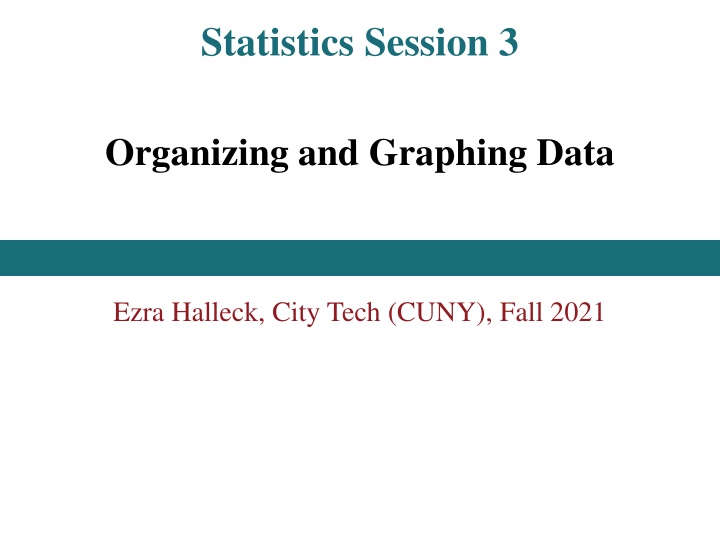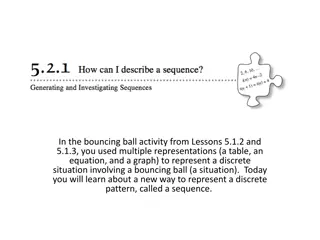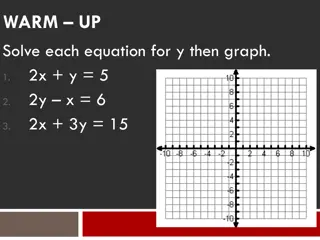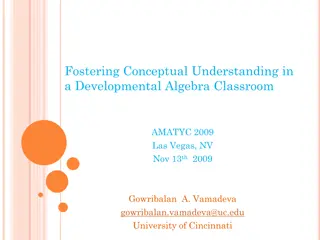
Organizing and Graphing Qualitative Data in Statistics Session 3
Explore the process of organizing and graphing qualitative data in Statistics Session 3 with examples, tables, and frequency distributions. Understand how to represent data effectively for analysis and interpretation.
Download Presentation

Please find below an Image/Link to download the presentation.
The content on the website is provided AS IS for your information and personal use only. It may not be sold, licensed, or shared on other websites without obtaining consent from the author. If you encounter any issues during the download, it is possible that the publisher has removed the file from their server.
You are allowed to download the files provided on this website for personal or commercial use, subject to the condition that they are used lawfully. All files are the property of their respective owners.
The content on the website is provided AS IS for your information and personal use only. It may not be sold, licensed, or shared on other websites without obtaining consent from the author.
E N D
Presentation Transcript
Statistics Session 3 Organizing and Graphing Data Ezra Halleck, City Tech (CUNY), Fall 2021
2.1 Organizing and Graphing Qualitative Data Definition Data recorded in the sequence in which they are collected and before they are processed or ranked are raw data. 2
Table 2.1 Ages of 50 Students 21 18 25 22 25 19 20 19 28 23 24 19 31 21 23 25 22 19 20 37 29 19 23 22 27 34 19 23 22 23 26 25 23 21 21 27 22 19 20 25 37 25 23 19 21 33 23 26 21 24 3
Table 2.2 Status of 50 Students J F J F F F SO J SE J F SE F SO SO SE J F J F F J SE SE J J F J J J J SO F SO J SE SE F SO SO SO J SE SO SO SO SE SE SE SO 4
Organizing and Graphing Qualitative Data Frequency Distributions Relative Frequency and Percentage Distributions Graphical Presentation of Qualitative Data 5
Table 2.3 Worries About Not Having Enough Money to Pay Normal Monthly Bills 6
Frequency Distributions Definition A frequency distribution of a qualitative variable lists all categories and the number of elements that belong to each of the categories. 7
Example 2-1 A sample of 30 persons who often consume donuts were asked what variety of donuts is their favorite. The responses from these 30 persons are as follows: glazed frosted glazed frosted filled filled filled plain plain other other filled other other frosted plain glazed glazed other glazed glazed other glazed frosted glazed other frosted filled filled filled Construct a frequency distribution table for these data. 8
Table 2.4 Frequency Distribution of Favorite Donut Variety Frequency (f) 8 7 5 3 7 Sum = 30 Donut Variety Glazed Filled Frosted Plain Other Blank Tally 8 tally marks 7 tally marks 5 tally marks 3 tally marks 7 tally marks Blank 9
Relative Frequency and Percentage Distributions Calculating Relative Frequency of a Category Frequency of that category Sum of all frequencies = Relative frequency of a category Calculating Percentage ( ) = Percentage Relative frequency 100% 10
Table 2.5: relative frequency and percentage distributions for the data in Table 2.4. Donut Variety Glazed Relative Frequency 8 over 30 = .267 .267 30= 7 .233 30= 5 .167 30= Percentage .267(100) = 26.7 8 Filled 7 over 30 = .233 .233(100) = 23.3 Frosted 5 over 30 = .167 .167(100) = 16.7 3 Plain 3 over 30 = .100 .100 30= .100(100) = 10.0 7 Oilier 7 over 30 = .233 .233 30= .233(100) = 23.3 Blank Sum = 1.000 Sum = 100% Note how the frequencies 8, 7, 5, 3 and 7 appear as the numerators of the fractions in the middle column. 11
Graphical Presentation of Qualitative Data (1 of 3) A graph made of bars whose heights represent the frequencies of respective categories is a bar graph. Figure 2.1 Bar Graph for Table 2.4: 12
Graphical Presentation of Qualitative Data (2 of 3) A Pareto chart is a bar graph with bars arranged by their heights in descending order: the bar with the largest height appears first; o subsequent bars are arranged in descending order; o bar with smallest height appears last. Figure 2.2 Pareto Chart for Table 2.4 o 13
Graphical Presentation of Qualitative Data (3 of 3) A pie chart is a circle divided into portions that represent relative frequencies or percentages of a population or sample belonging to different categories. Figure 2.2 Pie Chart for Percentage Distribution of Table 2.5: 14
2.2 Organizing and Graphing Quantitative Data Frequency Distribution Tables Often data are put into classes or bins. Graphing Grouped Data Often in the form of a histogram, a bar graph with no gaps. 15
Table 2.6 Earnings of employees in a Company This 2 to 1 ratio for the top earners to the bottom earners is uncommon in the US. More typical is for the top executives to have salaries, 100 s or even 1000 s of times that of their lowest paid workers. 16
Frequency Distributions for Quantitative Data A frequency distributionfor quantitative data lists all classes and the # of values that belong to each class. The data presented in this table are said to be grouped. 17
Frequency Distributions for Quantitative Data (cont) Finding Class Width Width of a class = Lower limit of the next class Lower limit of the current class Calculating Class Midpoint or Mark + Lower limit Upper limit = Class midpoint or mark 2 Calculation of Class Width Largest value Number of classes Smallest value = Approximate class width 18
Class Widths and Class Midpoints for Table 2.6 Class Limits 801 to 1000 1001 to 1200 1201 to 1400 1401 to 1600 1601 to 1800 1801 to 2000 Class Width 200 200 200 200 200 200 Class Midpoint 900.5 1100.5 1300.5 1500.5 1700.5 1900.5 19
Example 2-3 The following is a fragment of table giving the value (in million dollars) of each of the 30 baseball teams (source: Forbes Magazine, April 13, 2015). Value Team Value (millions of dollars) Kansas City Royals Los Angeles Angels of Anaheim Los Angeles Dodgers Miami Marlins Milwaukee Brewers Minnesota Twins New York Mets New York Yankees Oakland Athletics Philadelphia Phillies Pittsburgh Pirates 700 1300 2400 650 875 895 1350 3200 725 1250 900 Construct a frequency distribution table. Note the min and max for this fragment. 20
Example 2-3: Solution The minimum value is 605 (Tampa Bay Rays, not in fragment); the maximum value is 3200 (New York Yankees). We group these data using six classes of equal width. Then, 3200 605 6 = = Approximate width of each class 432.5 We round this approximate width to a convenient number, say 450. The lower limit of the first class can be taken as 605 or any # < 605. For readability, we take 601 as the lower limit of the first class. Then our classes are: 601 1050, 1051 1500, 1501 1950, 1951 2400, and 2851 3300 21
Table 2.8 Frequency Distribution for the Values of Baseball Teams, 2015 Value of a Team (in million$) 601 1050 1051 1500 1551 1950 1951 2400 2401 2850 2851 3300 Blank Number of Teams (f) 16 9 1 3 0 1 Tally 16 tally marks 9 tally marks 1 tally mark 3 tally marks Blank 1 tally mark Blank f = 30 Summation of f = 30 22
Relative Frequency and Percentage Frequencyof thatclass Sumof allfrequencies f Relativefrequencyof aclass = = f ( ) Percentage = Relativefrequency 100% Example 2.4 Calculate the relative frequencies and percentages for Table 2.8. 23
Example 2-4: Solution Relative Frequency and Percentage Distribution for the Values of Baseball Teams, 2015 Value of a Team (in million $) 601-1050 Relative Frequency 16 over 30 = .533 Percentage 53.3 16 30= 9 30= .533 1051- 1500 9 over 30 = .300 .300 1 .033 30= 3 .100 30= 0 .000 30= 1 .033 30= 30.0 1501-1950 1 over 30 = .033 3.3 1951-2400 3 over 30 = .100 10.0 2401-2850 0 over 30 = .000 0.0 2851-3300 1 over 30 = .033 3.3 Blank Sum = 1.000 Sum = 100% Note how the frequencies 16, 9, 1, 3, 0 and 1 appear as the numerators of the fractions in the middle column. 24
Graphing Grouped Data: histogram A histogram is a graph in which classes are marked on the horizontal axis and o the frequencies o relative frequencies o or percentages are represented by the heights of the bars. Unlike a bar graph for categorical data, in a histogram: the bars are drawn adjacent to each other. 25
Histograms for Table 2.8 Frequency Percentage Note how the bars are labeled with the midpoints. Alternatively, we can label using the intervals (as done on next slide); Or the boundaries are labeled instead (as done by Rguroo). 26
Graphing Grouped Data: polygon A graph formed by joining the midpoints of the tops of successive bars in a histogram with straight lines is a polygon. Figure 2.6 Frequency Polygon for Table 2.8 27 An empty bin has been added to each end so that the graph starts and ends on the x-axis.
Example 2-6 The administration in a large city wanted to know the distribution of vehicles owned by households in that city. A sample of 40 randomly selected households from this city produced the following data on the number of vehicles owned: 5 1 2 4 1 3 1 2 1 3 2 1 2 0 2 1 0 2 1 2 1 5 2 1 1 1 2 1 2 2 1 4 1 3 1 1 1 4 1 3 Construct a frequency distribution table for these data using single- valued classes. 28
Example 2-6: Solution Table 2.12 Frequency Distribution of Vehicles Owned Number of Households (f) 2 18 11 4 3 2 f = The observations assume only six distinct values: 0, 1, 2, 3, 4 and 5. Each of these six values is used as a class in the frequency distribution in Table 2.12. Vehicles Owned 0 1 2 3 4 5 Blank 40 Summation of f = 40 29
Figure 2.8 Bar Graph for Table 2.12 Since each bin represents a single outcome as opposed to a range of outcomes, we place gaps between the bars. 30
Cumulative Frequency Distributions A cumulative frequency distribution gives the total # of values that fall below the upper boundary of each class. Using Table 2.8, reproduced here, prepare a cumulative frequency distribution for the values of the baseball teams. Value of a team (in million $) 601 1050 1051 1500 1051 1950 1951 2400 2401 2850 2851 3300 # of Class Limits 601 1050 601 1500 601 1950 601 2400 601 2850 601 3300 Cumulative Frequency 16 16 + 9 = 25 16 + 9 + 1 = 26 16 + 9 + 1 + 3 = 29 16 + 9 + 1 + 3 + 0 = 29 16 + 9 +1 + 3 + 0 + 1 = 30 Teams (f) 16 9 1 3 0 1 31
Cumulative Relative Frequency and Percentage We can represent the cumulative distribution using Relative Frequency and Percentage: Cumulative frequency of a class Total observations in the data set Cumulative relative frequency 100 = Cumulative relative frequency ( ) = Cumulative percentage 32
Cumulative relative frequency and percentage distributions for the values of the baseball teams. Cumulative Relative Frequency 16 over 30 = .5333 16 .5333 30= 25 .8333 30= Cumulative Percentage 53.33 Class Limits 601-1050 601-1500 25 over 30 = .8333 83.33 601-1950 26 over 30 = .8667 26 .8667 30= 86.67 601-2400 29 over 30 = .9667 29 .9667 30= 96.67 601-2850 29 over 30 = .9667 29 .9667 30= 30 1.000 30= 96.67 601-3300 30 over 30 = 1.000 100.00 Note how the cumulative frequencies 16, 25, 26, 29, 29 and 30 appear as the numerators of the fractions in the middle column. 33
Some important Shapes of Histograms 1. Symmetric (about the center) 2. Skewed (right or left) 3. Uniform or Rectangular 34
Symmetric Right Left 35
A Histogram for a Uniform Distribution Theoretical; In practice The underlying distribution can be smooth, but a relatively small sample will appear jagged due to random variation. For a concrete example, roll a die 50 times, make a tally and then graph results. 36
Bar Graph Truncation: considered poor practice! without Truncation of the Vertical Axis with Truncation of the Vertical Axis Why do you think this is discouraged? 37






















